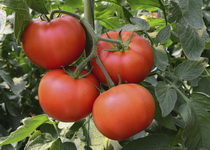
Scientists Uncover Signalling Pathway of Long-Established Immune Receptor
February 10, 2016| |
 A team of scientists at The Sainsbury Laboratory (TSL) and Wageningen University has uncovered one of the mechanisms of tomato plants' defense against disease-causing pathogens. Plants are under constant attack by pathogens such as bacteria and fungi. To prevent infections, plants have an innate immune system, which detects pathogens and initiates defense.
A team of scientists at The Sainsbury Laboratory (TSL) and Wageningen University has uncovered one of the mechanisms of tomato plants' defense against disease-causing pathogens. Plants are under constant attack by pathogens such as bacteria and fungi. To prevent infections, plants have an innate immune system, which detects pathogens and initiates defense.
In 1994, Professor Jonathan Jones and his group at TSL identified Cf-9, a tomato gene that encodes a receptor-like protein which confers resistance to a specific strain of the tomato leaf mold fungus (Cladosporium fulvum). Receptor-like proteins, together with receptor kinases, are the two main types of plant immune receptors found on the surface of plant cells. Unlike receptor kinases, the receptor-like proteins have no signalling domain within the cell. It has therefore been a long-standing question how receptor-like proteins can activate intracellular signalling cascades.
The TSL team used live-cell imaging, gene silencing and coimmunoprecipitation to provide direct evidence of an interaction between Cf-4, a receptor-like protein, and BAK1/SERK3, a co-receptor kinase, thus finally answering this long-standing question by revealing the mechanism that initiates the Cf-4-induced immune response in tomato.
For more details, read the news release at the TSL website.
| |
Biotech Updates is a weekly newsletter of ISAAA, a not-for-profit organization. It is distributed for free to over 22,000 subscribers worldwide to inform them about the key developments in biosciences, especially in biotechnology. Your support will help us in our mission to feed the world with knowledge. You can help by donating as little as $10.
-
See more articles:
-
News from Around the World
- Naturally Occurring Plant Enzyme to Increase Wheat Yields
- "Molecular Memory" Helps Plants Remember Daylight During Winter
- Study Explains How Corn Plants Fight Off Simultaneous Attacks
- Ancient Gene Network Helps Plants Adapt to Their Environments
- Charu Mayee Awarded "Majha Sheti Sanman Puraskar"
- Punjab Seed Council Approves New Seedless Citrus
- 4th Public Consultation Held for Revised GM Regulatory Guidelines in the Philippines
- Vitamin B6 Role in Plants Discovered
- Scientists Uncover Signalling Pathway of Long-Established Immune Receptor
-
Research Highlights
- Comparative Analysis of Cotton Near Isogenic Lines Reveal Genes Related to High Fiber Strength
- Metabolic Engineering of Terpene Biosynthesis using a Transcription Factor MsYABBY5 from Spearmint
- Development of a Novel Transgenic Cotton to Control Bollworm
-
Beyond Crop Biotech
- Researchers Identify Genetic Makeup of Dangerous E. coli Strains
- WSU Researchers Discover How a Helpful Protein Can also Cause Cancer
-
From the BICs
- Philippine and Thailand BICs Join Cornell Alliance for Science Asia Leadership Course
-
Read the latest: - Biotech Updates (April 24, 2024)
- Gene Editing Supplement (April 24, 2024)
- Gene Drive Supplement (February 22, 2023)
-
Subscribe to BU: - Share
- Tweet
